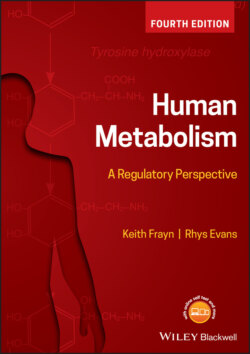Читать книгу Human Metabolism - Keith N. Frayn - Страница 19
Box 1.2 Redox reactions
ОглавлениеOxygen is a powerful oxidising agent (the word ‘oxidising’ derives from oxygen) and is used in metabolism as an electron acceptor. Hydrogen is the reducing agent in many biological reactions and hence reduction could be termed ‘hydrogenation’ although this term has a specific meaning in chemistry, referring to the addition of hydrogen.
Oxidation and reduction are characterised by a change in the oxidation state of the atoms involved. The oxidation state is the (theoretical) charge (its electron status or ‘count’) that an atom would have if all its bonds were entirely ionic (not true in practice due to covalent bonding) – hence oxidation state denotes the degree of oxidation of an atom; it may be positive, zero, or negative, and an increase in oxidation state during a reaction denotes oxidation of the atom, whilst a decrease denotes reduction, both resulting from electron transfer. The tendency of an atom to attract electrons to itself (i.e. to act as an oxidising agent) is denoted by its electronegativity, and is partly a function of the distribution of its own (valence) electrons; by contrast, the tendency of an atom to donate electrons (i.e. to act as a reducing agent) is denoted by its electropositivity.
The chemically usable energy in a biomolecule which is a metabolic substrate is therefore present in the form of electrons, and therefore electron-rich molecules will be energy-rich and serve as good energy sources for metabolism. All three major metabolic substrate groups – carbohydrates, lipids, and proteins – contain these electrons in association with carbon-hydrogen (C–H) bonds. They can all be thought of as reduced (electron-rich) carbon (as found in wood, coal, house gas, and heating oil). In energy-yielding metabolism they act as reducing agents, donating these electrons to an electron acceptor, and ultimately themselves getting oxidised (the carbon ending up fully oxidised as CO2 and the hydrogen as H2O). The ultimate electron acceptor (oxidising agent) is, of course, oxygen.
e.g.
This demonstrates the importance of oxygen in metabolism: a strong electron acceptor is required to permit adequate electron transfer (and energy yield) from energy-rich substrates to occur, the difference in free energy levels between the tendency of the reducing agent to donate electrons and of the oxidising agent to accept electrons representing the energy yield of the overall process. (This may be contrasted with fermentation reactions which do not involve net reduction-oxidation, for example glycolysis of glucose to lactate: the energy yield is too small to sustain mammalian energy requirements and the substrate must be oxidised to maximise energy yield.) It can also be seen that lipids (e.g. fatty acids: CH3(CH2)n·COOH, where n is typically 12–16, Figure 1.4) are far more reduced (C–H bond-rich; electron-rich) than carbohydrates (e.g. glucose C6H12O6), in which the carbon atoms are already partially oxidised, with fewer C–H bonds and therefore fewer energy-rich electrons to donate, and hence lipids contain far more energy (per gram) than carbohydrates. Amino acids are comparable to carbohydrates in the state of reduction of their carbon atoms, and hence of their energy content.
However, if electrons were transferred directly from substrate (e.g. glucose, fatty acid) to oxygen, the large energy yield would be uncontrollable. Therefore, a long series of intermediary electron transfer (redox) reactions occur in which energy-rich e− is transferred sequentially and incrementally down a gradually decreasing (free) energy gradient. This explains why metabolic pathways are relatively long with many steps: small amounts only of energy are given off at each step. The energy (electron) extracted is then conveyed by electron carriers. Examples of electron carriers are NAD+, NADP+, and FAD. These are of course redox compounds themselves, accepting electrons (in the form of hydride ions H−, i.e. a hydrogen atom with the extra, energy-carrying electron) from the metabolic pathway (becoming reduced – e.g. NADH; NADPH; FADH2) and passing them on (becoming re-oxidised) to further carriers at sequentially lower energy levels (electron transport chain redox proteins) until ultimately oxygen accepts the electrons, becoming itself reduced to water. It is for this reason that many key energy-yielding reactions in metabolic pathways are catalysed by dehydrogenase enzymes linked to transfer of a hydride ion H− to the hydride acceptor NAD+:
The redox state of a cell refers to the proportion of these intermediary electron carriers that are in the reduced (high energy) state compared to those in the oxidised (low energy) form: the NAD+: NADH ratio for example provides an estimate of the energetic ‘charge’ (potential) contained within the cell (in an analogous fashion to the phosphorylation potential denoting the amount of adenine nucleotide in the form of ATP) – it is for this reason that many metabolic pathways are regulated not only by the phosphorylation potential ([ATP]: [ADP] and [AMP]) but, as we are increasingly recognising, also by the redox potential (NAD+: NADH; NADP+:NADPH).
